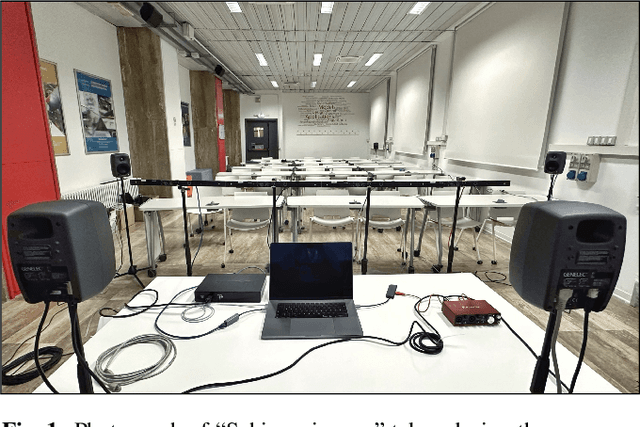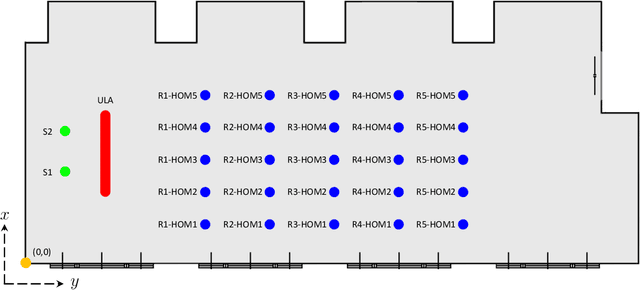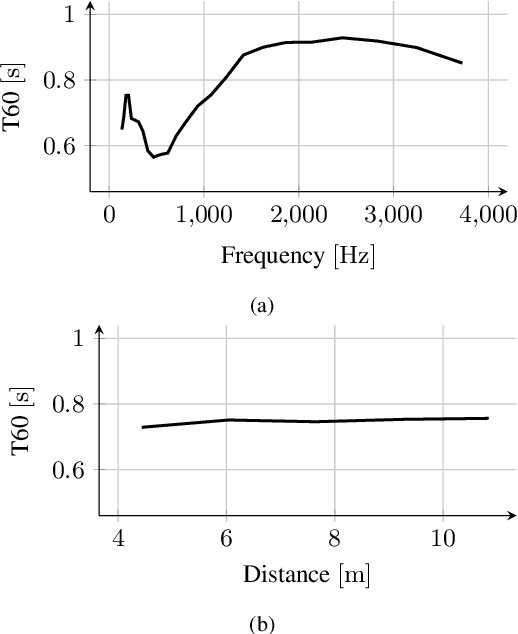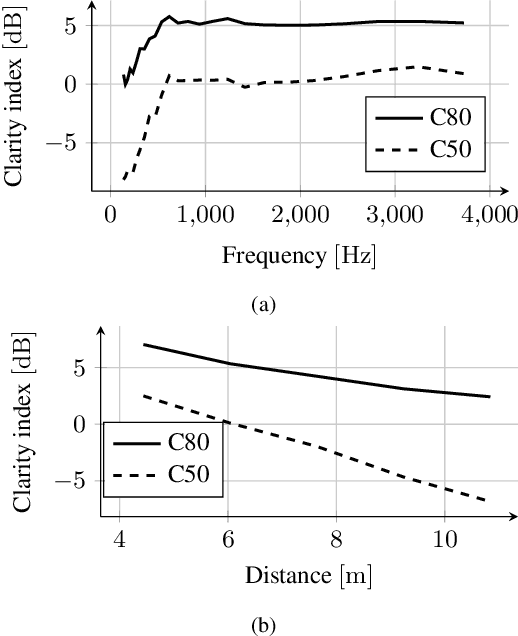Luca Comanducci
Towards HRTF Personalization using Denoising Diffusion Models
Jan 06, 2025Abstract:Head-Related Transfer Functions (HRTFs) have fundamental applications for realistic rendering in immersive audio scenarios. However, they are strongly subject-dependent as they vary considerably depending on the shape of the ears, head and torso. Thus, personalization procedures are required for accurate binaural rendering. Recently, Denoising Diffusion Probabilistic Models (DDPMs), a class of generative learning techniques, have been applied to solve a variety of signal processing-related problems. In this paper, we propose a first approach for using DDPM conditioned on anthropometric measurements to generate personalized Head-Related Impulse Response (HRIR), the time-domain representation of HRTF. The results show the feasibility of DDPMs for HRTF personalization obtaining performance in line with state-of-the-art models.
FakeMusicCaps: a Dataset for Detection and Attribution of Synthetic Music Generated via Text-to-Music Models
Sep 16, 2024



Abstract:Text-To-Music (TTM) models have recently revolutionized the automatic music generation research field. Specifically, by reaching superior performances to all previous state-of-the-art models and by lowering the technical proficiency needed to use them. Due to these reasons, they have readily started to be adopted for commercial uses and music production practices. This widespread diffusion of TTMs poses several concerns regarding copyright violation and rightful attribution, posing the need of serious consideration of them by the audio forensics community. In this paper, we tackle the problem of detection and attribution of TTM-generated data. We propose a dataset, FakeMusicCaps that contains several versions of the music-caption pairs dataset MusicCaps re-generated via several state-of-the-art TTM techniques. We evaluate the proposed dataset by performing initial experiments regarding the detection and attribution of TTM-generated audio.
MambaFoley: Foley Sound Generation using Selective State-Space Models
Sep 13, 2024



Abstract:Recent advancements in deep learning have led to widespread use of techniques for audio content generation, notably employing Denoising Diffusion Probabilistic Models (DDPM) across various tasks. Among these, Foley Sound Synthesis is of particular interest for its role in applications for the creation of multimedia content. Given the temporal-dependent nature of sound, it is crucial to design generative models that can effectively handle the sequential modeling of audio samples. Selective State Space Models (SSMs) have recently been proposed as a valid alternative to previously proposed techniques, demonstrating competitive performance with lower computational complexity. In this paper, we introduce MambaFoley, a diffusion-based model that, to the best of our knowledge, is the first to leverage the recently proposed SSM known as Mamba for the Foley sound generation task. To evaluate the effectiveness of the proposed method, we compare it with a state-of-the-art Foley sound generative model using both objective and subjective analyses.
PAGURI: a user experience study of creative interaction with text-to-music models
Jul 05, 2024


Abstract:In recent years, text-to-music models have been the biggest breakthrough in automatic music generation. While they are unquestionably a showcase of technological progress, it is not clear yet how they can be realistically integrated into the artistic practice of musicians and music practitioners. This paper aims to address this question via Prompt Audio Generation User Research Investigation (PAGURI), a user experience study where we leverage recent text-to-music developments to study how musicians and practitioners interact with these systems, evaluating their satisfaction levels. We developed an online tool through which users can generate music samples and/or apply recently proposed personalization techniques, based on fine-tuning, to make the text-to-music model generate sounds closer to their needs and preferences. Using questionnaires, we analyzed how participants interacted with the proposed tool, to understand the effectiveness of text-to-music models in enhancing users' creativity. Results show that even if the audio samples generated and their quality may not always meet user expectations, the majority of the participants would incorporate the tool in their creative process. Furthermore, they provided insights into potential enhancements for the system and its integration into their music practice.
Interpreting End-to-End Deep Learning Models for Speech Source Localization Using Layer-wise Relevance Propagation
Apr 04, 2024



Abstract:Deep learning models are widely applied in the signal processing community, yet their inner working procedure is often treated as a black box. In this paper, we investigate the use of eXplainable Artificial Intelligence (XAI) techniques to learning-based end-to-end speech source localization models. We consider the Layer-wise Relevance Propagation (LRP) technique, which aims to determine which parts of the input are more important for the output prediction. Using LRP we analyze two state-of-the-art models, of differing architectural complexity that map audio signals acquired by the microphones to the cartesian coordinates of the source. Specifically, we inspect the relevance associated with the input features of the two models and discover that both networks denoise and de-reverberate the microphone signals to compute more accurate statistical correlations between them and consequently localize the sources. To further demonstrate this fact, we estimate the Time-Difference of Arrivals (TDoAs) via the Generalized Cross Correlation with Phase Transform (GCC-PHAT) using both microphone signals and relevance signals extracted from the two networks and show that through the latter we obtain more accurate time-delay estimation results.
Synthesizing Soundscapes: Leveraging Text-to-Audio Models for Environmental Sound Classification
Mar 26, 2024Abstract:In the past few years, text-to-audio models have emerged as a significant advancement in automatic audio generation. Although they represent impressive technological progress, the effectiveness of their use in the development of audio applications remains uncertain. This paper aims to investigate these aspects, specifically focusing on the task of classification of environmental sounds. This study analyzes the performance of two different environmental classification systems when data generated from text-to-audio models is used for training. Two cases are considered: a) when the training dataset is augmented by data coming from two different text-to-audio models; and b) when the training dataset consists solely of synthetic audio generated. In both cases, the performance of the classification task is tested on real data. Results indicate that text-to-audio models are effective for dataset augmentation, whereas the performance of the models drops when relying on only generated audio.
HOMULA-RIR: A Room Impulse Response Dataset for Teleconferencing and Spatial Audio Applications Acquired Through Higher-Order Microphones and Uniform Linear Microphone Arrays
Feb 21, 2024



Abstract:In this paper, we present HOMULA-RIR, a dataset of room impulse responses (RIRs) acquired using both higher-order microphones (HOMs) and a uniform linear array (ULA), in order to model a remote attendance teleconferencing scenario. Specifically, measurements were performed in a seminar room, where a 64-microphone ULA was used as a multichannel audio acquisition system in the proximity of the speakers, while HOMs were used to model 25 attendees actually present in the seminar room. The HOMs cover a wide area of the room, making the dataset suitable also for applications of virtual acoustics. Through the measurement of the reverberation time and clarity index, and sample applications such as source localization and separation, we demonstrate the effectiveness of the HOMULA-RIR dataset.
Room transfer function reconstruction using complex-valued neural networks and irregularly distributed microphones
Feb 01, 2024Abstract:Reconstructing the room transfer functions needed to calculate the complex sound field in a room has several important real-world applications. However, an unpractical number of microphones is often required. Recently, in addition to classical signal processing methods, deep learning techniques have been applied to reconstruct the room transfer function starting from a very limited set of room transfer functions measured at scattered points in the room. In this study, we employ complex-valued neural networks to estimate room transfer functions in the frequency range of the first room resonances, using a few irregularly distributed microphones. To the best of our knowledge, this is the first time complex-valued neural networks are used to estimate room transfer functions. To analyze the benefits of applying complex-valued optimization to the considered task, we compare the proposed technique with a state-of-the-art real-valued neural network method and a state-of-the-art kernel-based signal processing approach for sound field reconstruction, showing that the proposed technique exhibits relevant advantages in terms of phase accuracy and overall quality of the reconstructed sound field.
Reconstruction of Sound Field through Diffusion Models
Dec 14, 2023

Abstract:Reconstructing the sound field in a room is an important task for several applications, such as sound control and augmented (AR) or virtual reality (VR). In this paper, we propose a data-driven generative model for reconstructing the magnitude of acoustic fields in rooms with a focus on the modal frequency range. We introduce, for the first time, the use of a conditional Denoising Diffusion Probabilistic Model (DDPM) trained in order to reconstruct the sound field (SF-Diff) over an extended domain. The architecture is devised in order to be conditioned on a set of limited available measurements at different frequencies and generate the sound field in target, unknown, locations. The results show that SF-Diff is able to provide accurate reconstructions, outperforming a state-of-the-art baseline based on kernel interpolation.
Timbre transfer using image-to-image denoising diffusion implicit models
Jul 28, 2023



Abstract:Timbre transfer techniques aim at converting the sound of a musical piece generated by one instrument into the same one as if it was played by another instrument, while maintaining as much as possible the content in terms of musical characteristics such as melody and dynamics. Following their recent breakthroughs in deep learning-based generation, we apply Denoising Diffusion Models (DDMs) to perform timbre transfer. Specifically, we apply the recently proposed Denoising Diffusion Implicit Models (DDIMs) that enable to accelerate the sampling procedure. Inspired by the recent application of DDMs to image translation problems we formulate the timbre transfer task similarly, by first converting the audio tracks into log mel spectrograms and by conditioning the generation of the desired timbre spectrogram through the input timbre spectrogram. We perform both one-to-one and many-to-many timbre transfer, by converting audio waveforms containing only single instruments and multiple instruments, respectively. We compare the proposed technique with existing state-of-the-art methods both through listening tests and objective measures in order to demonstrate the effectiveness of the proposed model.
 Add to Chrome
Add to Chrome Add to Firefox
Add to Firefox Add to Edge
Add to Edge